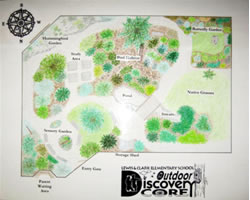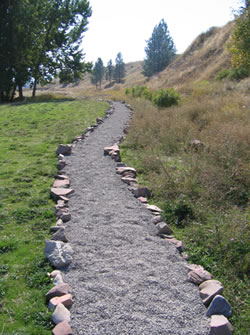
Arlee School Staff constructing the native plant garden
Arlee Elementary School
Project T.E.D (Teaching Ecological Diversity)
Teachers: Bonnie Barger, Ronda Howlett
Ecologists in Residence: Matt Corsi, Florence Gardipee
Demonstration Project:
We proposed that Project TED would conform to a theme to teach ecological diversity. In order to match that theme, we determined the garden would consist of native plant life that was culturally important to the Salish and Kootenai peoples. We also determined that Project TED should serve as a functional outdoor classroom where teachers could conduct science education and other curricula in an aesthetically pleasing environment. To create that functional classroom, our proposal called for installation of four all-purpose tables that students can sit, stand, or run experiments on.
We designed the garden with plantings to attract local birds and insects so the classroom will provide constant natural stimulation. The proposed interpretive infrastructure of Project TED will be focused towards promoting ecological and cultural literacy. All plant species in the garden will have an associated informational placard. We also proposed the placement of cement casts of common animal tracks along the primary path of the garden with associated placards. All placards will include the common name, the Latin name, and the traditional Salish name of the organism. We originally proposed to build four small signs for each of the four cardinal directions visible from the edges of the garden. On each of these signs will be an artist’s rendition of the mountain view behind the sign with short descriptions of geologic, ecological, and cultural history of the mountains in the view.
Read more in the Arlee Final Report (pdf format)

Clinton Elementary Students help build the greenhouse.
Clinton Elementary School
ESCAPE (Energized Students at Clinton Applying Principles of Ecology)
Teachers: Kathy Kaiser, Mandy McGill
Ecologists in Residence: John MacLean, Joss McKinnon
Demonstration Project:
The theme of our demonstration project was ESCAPE—Energized Students at Clinton Applying Principles of Ecology. Our goal was to bring students into the beautiful outdoor setting surrounding the Clinton school to let them pursue inquiries regarding ecology. As part of this goal, we built a new greenhouse available to all grade levels at the school (K-8).
This structure provides an outdoor laboratory that will engage students in several energy concepts, including solar energy, photosynthesis, and biodegradation. The greenhouse will be available for years to come as an environment in which students can conduct experiments to discover energy relationships in the natural world.
Read more in the Clinton Elementary Final Report (pdf format)

Hellgate ECOS teachers
Kathy Meyers and Colleen Cooper
describe the demonstration project
to the 3rd-5th grade classes.
Hellgate Elementary School
Native Garden
Teachers: Colleen Cooper, Mike Machura
Ecologists in Residence: Mary Bricker, Nathan Gordon
Demonstration Project:
Hellgate has completed its second year as an ECOS school. Last year’s fellows worked with 3rd and 7th grade classes to establish four learning centers on the schoolyard. This year’s demonstration project was designed to build upon one of those learning centers – a native medicinal plant garden – to create an exciting outdoor learning environment in the 3rd -5th grade building’s entry courtyard. In order to accomplish this task, our original proposal consisted of three primary goals:
- Enhance and build upon the native medicinal plant garden established last year by third-grade ECOS teacher Jo Fix by relocating the garden to a more suitable location at the entryway of the school and planting additional plant species.
- Install student work stations to make the courtyard usable as an outdoor classroom.
- Create a guide (pdf format) appropriate for all grade levels that includes ecology investigations designed for the garden and outdoor classroom.
A central goal of our demonstration project was to ensure that the garden becomes a usable resource for other teachers in the school, whether they have been involved in ECOS or not. To accomplish this, we proposed to produce educational materials including signs (showing common and scientific names), field guides and lesson plans as complements to the garden.
As an educational component to the native plant garden, we proposed to create a series of scientific lesson plans and student-friendly plant guides. These would include student-written descriptions of each species. In order to do this, our fifth grade students would research other published plant guides and the Northern Rockies Natural History Guide. We planned to work with teachers and students to write species descriptions in language accessible to students in the 3rd -5th grade age groups. This guide would also include inquiry-based lesson plans to be used in the garden and surrounding schoolyard. Some of these lessons were also intended to focus on the ways these plant species are and have been used by Montana’s Native American tribes, making it an excellent resource for helping meet the goals of Montana’s Indian Education for All Act.
Dowload the Hellegate Native Garden Guide (pdf format)
Read more in the the Hellgate Elementary Final Report (pdf format)

A map of the Outdoor Discovery Core
Lewis and Clark Elementary School
No Teacher Left Indoors
Teachers: Christy Meurer, Betsy Sharkey
Ecologists in Residence: Alison Perkins, Nathan Gordon
Demonstration Project:
The Lewis and Clark Elementary ECOS team wanted to focus on providing resources for the entire school, hence the project theme No Teacher Left Indoors. The aim was to help the students and teachers at the school better utilize their schoolyard habitat. Lewis and Clark transformed a wonderful portion of the schoolyard into the Outdoor Discovery Core (ODC), containing a butterfly garden, sensory garden, bird habitat, hummingbird garden, native grass mound, and a flowing stream/pond feature. The site was dedicated as an official National Wildlife Federation Schoolyard Habitat Site. We found that the main obstacle to outdoor science education was curriculum. Teachers wanted to know how and what to teach outdoors. The goal of this project, then, was to provide all teachers with materials and inquiry experiences to empower them to use Outdoor Discovery Core to enrich and expand their science curricula. The project was designed to align with ECOS objectives by providing permanent resources teachers could use to enhance a variety of “learn-by-doing” inquiry lessons in the schoolyard and adjacent habitat areas. Our specific purposes were to enhance the Outdoor Discovery Core by adding equipment to broaden the scope of ecological inquiries and by providing support and additional materials to help teachers sustain the goal of “No Child Left Indoors.”
This project provided Lewis and Clark Elementary School with several different resources that focused on enhancing outdoor ecological education. These resources included a weather station, environmental temperature data loggers, personalized scientific inquiry CDs for teachers, and a new utility shed. These resources addressed science standards across grade levels (e.g., weather is a curriculum topic throughout K-5), and provided science data for long-term local and global study. They also equipped all Lewis and Clark teachers with additional information, methods, and resources for enriching and sustaining the ODC as a schoolyard laboratory. The project also aligned with the specialties of the ECOS fellows, providing an important resource for engaging teachers, parents, and students for lasting impact. Moreover, this year’s demonstration project built on the two previous demonstration projects in order to leave a lasting resource for the entire school community.
Read more in the the Lewis and Clark Final Report (pdf format)

This gravel path connects the Target Range
native plant garden
to the cottonwood ampitheatre.
Target Range School
Change on the Range
Teachers: Tara Barba, Randee Stephens
Ecologists in Residence: Jeff Piotrowski, Rebecca Wahl
Demonstration Project:
We built upon the foundation of the two previous years of ECOS involvement at Target Range School by tying together and adding to the previous demonstration projects. To do this, we outlined four main components to our demonstration project:
- To complete a gravel path connecting the two existing demonstration projects and install four student work tables in the native plant garden;
- To restore and fence in the native plant garden (1st year ECOS demonstration project) with the consultation and assistance of the ECOS teachers and fellows who installed it;
- To finish terracing and construction of the cottonwood grove amphitheatre (2nd year ECOS demonstration project) in consultation with the second-year ECOS teachers and fellows, and
- To construct a permanent, interpretive sign describing the entire demonstration project.
Items (1) and (4) are the specific contribution of this year’s teachers, fellows, and students, and will be acknowledged as such. Items (2) and (3) are designed to help make the previous ECOS projects at Target Range sustainable in the long-term.
To compliment these construction projects, we developed and compiled a series of ecological inquiries that specifically use these outdoor areas. We are collating these inquiries and presenting them to the teachers at the school so that future classes can use the outdoor classroom. Along with these inquiries, we will leave guidelines for maintaining the areas so that they do not fall into disrepair over time.
Read more in the Target Range Final Report (pdf format)

An example of the drawings that
accompany the insect key
.
Special Project Fellow
Insect Key
Special Project Fellow: Jen Marangelo
Demonstration Project Proposal:
I developed the insect section of the ECOS Guide to the Ecology of the Northern Rockies, an on-line field guide. This involved developing a key, selecting the species to be drawn for the key, writing descriptions for 15 insect orders and 10 families, developing introductory sections on arthropods in general, why we should care about insects, what is an insect?, how insects develop, how to find and observe insects in the field, a glossary and instructions on how to use the key.
Insect identification can be a challenging task. Even the “easiest” keys use confusing terminology and require the user to look for characteristics on insects that are difficult, if not impossible to see. In order to simplify the task I’ve combined two methods of identification: a dichotomous key and matching the organism with a picture.
Read more in the Final Report (pdf format)


